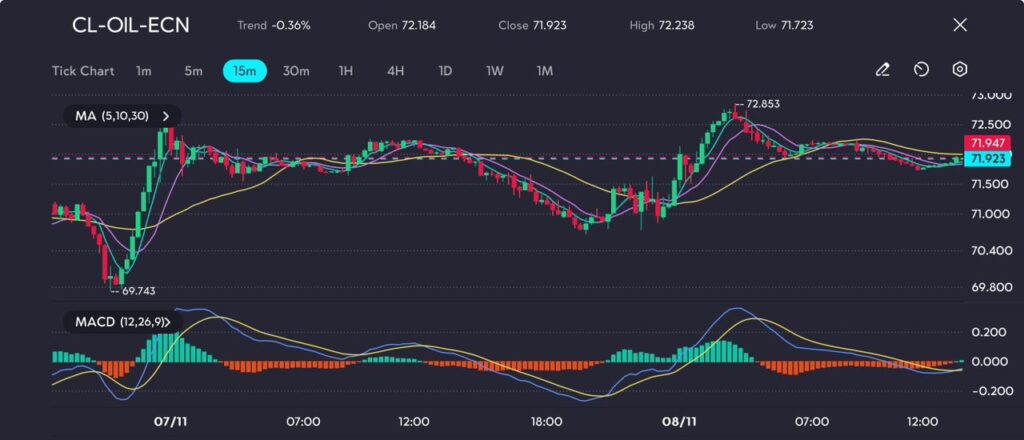Listen to the article here:
Key Points:
- Brent crude fell 0.6% to $75.16 per barrel; WTI dipped 0.8% to $71.81, despite weekly gains.
- Market cautious on potential Trump administration policies that may restrict Iranian and Venezuelan oil supplies.
Oil prices saw a modest decline on Friday, with Brent crude futures slipping by 0.6% to $75.16 per barrel and U.S. West Texas Intermediate (WTI) falling 0.8% to $71.81.
This slight dip follows nearly 1% gains on Thursday, as traders closely monitor developments in the Gulf of Mexico and potential policy shifts from President-elect Donald Trump.

Picture: Crude oil prices stall near resistance at $72.85, as momentum shows signs of waning amid mixed signals, as seen on the VT Markets app.
We see a brief rally to the resistance level around 72.853, but prices began to consolidate and retrace slightly, settling around the 71.923 area.
The 5, 10, and 30-period moving averages indicate a recent bullish push, though they are starting to converge, suggesting possible short-term indecision or consolidation.
Hurricane Rafael’s Reduced Impact
Hurricane Rafael initially caused a shutdown of 391,214 barrels per day in U.S. crude production, sparking concerns over potential disruptions.
However, the hurricane is now expected to weaken over the weekend as it drifts westward away from critical oil fields, reducing its threat to U.S. oil output.
The National Hurricane Center’s forecast indicates a declining impact on production, leading to some easing in oil prices as traders adjust their expectations.
Trump’s Policies and Potential Supply Constraints
While the hurricane’s impact appears limited, market participants are focused on the policy direction under the incoming Trump administration.
Expected actions, such as tighter sanctions on Iran and Venezuela, could potentially restrict oil supplies from these countries, supporting higher prices in the medium term.
Although such sanctions would likely be implemented gradually, they could create supply constraints that might influence global oil balances if enforced rigorously.
See also: Oil Dips Ahead of US Election and China NPC
BMI, a unit of Fitch Solutions, noted in its analysis that while Trump’s rhetoric may suggest an aggressive stance, institutional constraints and moderate advisors may temper any drastic policy shifts.
BMI’s outlook anticipates a relatively pragmatic approach, with any direct impact on oil fundamentals likely to be limited through 2025.
Downward Pressure from Chinese Imports and U.S. Inventory Builds
Adding to the downward pressure, China, the world’s largest oil importer, reported a 9% drop in crude imports in October, marking the sixth consecutive month of year-on-year declines. This trend raises questions about demand strength from a key market and could weigh on global oil prices if it persists.
Additionally, U.S. crude inventories rose, further pressuring prices as concerns about near-term demand continue. Traders will likely remain cautious, balancing expectations of tighter supply due to potential U.S. sanctions with the mixed signals from demand and inventory data.
The market is set to navigate a complex environment where supply risks and geopolitical shifts will play pivotal roles in shaping near-term price movements.
Start trading now — click here to create your live VT Markets account.









